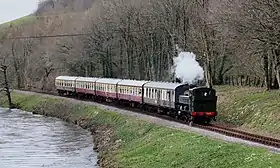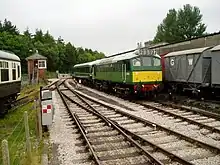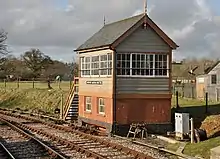South Devon Railway (heritage railway)
The South Devon Railway (SDR) is a 6.64-mile (10.69 km) heritage railway from Totnes to Buckfastleigh in Devon. Mostly running alongside the River Dart, it was initially known as the Dart Valley Railway. The railway is now operated by the South Devon Railway Trust, a registered charity.[1]
| South Devon Railway | |
|---|---|
 GWR pannier tank 1369 beside the River Dart near Staverton | |
| Terminus | Buckfastleigh 50.4824°N 3.7685°W Totnes 50.4400°N 3.6858°W |
| Commercial operations | |
| Name | British Rail |
| Built by | Buckfastleigh, Totnes and South Devon Railway |
| Original gauge | 7 ft 1⁄4 in (2,140 mm) Brunel gauge |
| Preserved operations | |
| Operated by | South Devon Railway Trust |
| Stations | 4 |
| Length | 6.64 miles (10.7 km) |
| Preserved gauge | 4 ft 8+1⁄2 in (1,435 mm) standard gauge |
| Commercial history | |
| Opened | 1872 |
| 1892 | Gauge conversion to 4 ft 8+1⁄2 in (1,435 mm) standard gauge |
| Closed | 1962 |
| Preservation history | |
| 1969 | Re-opened as Dart Valley Railway |
| 1991 | Became the South Devon Railway |
| Headquarters | Buckfastleigh |
The railway's headquarters and museum are located at Buckfastleigh railway station.
History
A 10.5-mile (16.9 km) railway between Newton Abbot and Ashburton received Parliamentary approval and Royal Assent in 1848. However, with the economy in recession the scheme failed to find sufficient backing. After the Parliamentary approval of construction of the South Devon Railway Company (SDR) from Exeter to Plymouth, a new Buckfastleigh, Totnes and South Devon Railway scheme was proposed to make a junction with the SDR at Totnes and link it with Buckfastleigh, running alongside the River Dart. It opened as a broad gauge line through to Ashburton on 1 May 1872 and was operated from the outset by the SDR (which became part of the Great Western Railway in 1876). The last passenger train ran on 3 November 1958 although freight traffic continued until 7 September 1962.[2]
Preservation

Having secured GWR 4500 Class Small Prairie Tank No.4555 for £750 from BR, Patrick Whitehouse and fellow "Birmingham Railway Mafia" member Pat Garland were looking to secure a GWR style branch line on which to run the locomotive. Both had been involved in the world's first ever heritage railway at the Talyllyn Railway, and so were seeking a complete and in-place railway. In partnership with fellow Talyllyn veteran Bill Faulkner and other local businessman,[3] having originally focused on the already closed GWR Kingsbridge branch. With the track already being removed there, they then focused on the Buckfastleigh to Ashburton branch. Their business plan was to launch and operate a profitable summer-season tourist railway, focused on the many summer visitors who choose to holiday in South Devon.[3]
Forming the Dart Valley Light Railway Company Ltd, it took ownership of the branch line in October 1965, and was granted a light railway order to operate in 1966. However, the Ministry for Transport insisted that the railway assist in improvements to the A38 road, and it was not until 1969 that an agreement was made to operate from Totnes to Buckfastleigh, with the section beyond to Ashburton and its unique remaining Brunel-style station lost to dual carriageway improvements to the A38 trunk road. The final severing of the line took place in 1971.[3]
The first passenger train ran on 5 April 1969, with Dr Richard Beeching performing the official opening ceremony on 21 May 1969.[4] Operated from the outset - as had the Talyllyn and the Ffestiniog Railway - as a commercial railway, in the first year the Dart Valley carried 60,000 passengers at a profit.[5]
In 1971, the company was offered the opportunity to purchase from British Rail the freehold of the Kingswear Branch, running from Paignton to Kingswear, and hence by ferry to Dartmouth. To complete the purchase, in 1972 the original preservation company became the "Dart Valley Railway Company plc" (DVR), although it was not listed on the London Stock Exchange.
South Devon Railway Trust
In 1989, the DVR plc publicly announced that the Totnes to Buckfastleigh line was uneconomic, and had hence decided to find another operator or close it. In response, the volunteers who assisted in running the line proposed to take over operations. As the articles of association of the resident GWR 4900 Class No. 4920 Dumbleton Hall charity allowed it to operate a railway, the joint-team proposed using that charity as its commercial vehicle to take over the line. Renamed the "South Devon Railway Trust", the railway was renamed the South Devon Railway, and the volunteer supporting body renamed the South Devon Railway Association. The Trust took over the running of the line on 1 January 1991, with the first train running on 29 March 1991. The Trust subsequently bought the freehold of the line from DVR plc on 8 February 2010. The South Devon Railway was named the Heritage Railway of the Year in 2007.
Accidents and incidents
A child almost fell from a carriage on 22 June 2017 whilst the train was in motion between Totnes Riverside and Buckfastleigh.[6] This was due to part of the floor in a toilet being missing following repairs to the carriage's brake system.[7][8] The Rail Accident Investigation Branch investigated what it called a "dangerous occurrence".[9] It released its report into the accident on 30 January 2018.[6] The investigation concluded that the railway's Safety Management System at the time was inadequate, and that there were deficiencies in the system to ensure vehicles were fit for service. One recommendation was made. It was revealed that the Office of Rail and Road (ORR) had issued an improvement notice in July 2017 and that the notice was deemed to have been complied with in November 2017.[8] The South Devon Railway was prosecuted by the ORR in May 2018 on a charge of failing to ensure people in its employ and passengers were not exposed to risk of harm. It pleaded guilty and was fined £40,000 with costs of £13,205 and a victim surcharge of £170.[10]
Route
| Point | Coordinates (Links to map resources) |
OS Grid Ref | Notes |
|---|---|---|---|
| Buckfastleigh | 50.4828°N 3.7688°W | SX746662 | |
| Staverton | 50.4610°N 3.7149°W | SX783637 | |
| Nappers Halt | 50.4613°N 3.7026°W | ||
| Totnes (Riverside) | 50.4398°N 3.6858°W |
South Devon Railway | ||||||||||||||||||||||||||||||||||||||||||||||||||||||||||||||||||||||||||||||||||||
|---|---|---|---|---|---|---|---|---|---|---|---|---|---|---|---|---|---|---|---|---|---|---|---|---|---|---|---|---|---|---|---|---|---|---|---|---|---|---|---|---|---|---|---|---|---|---|---|---|---|---|---|---|---|---|---|---|---|---|---|---|---|---|---|---|---|---|---|---|---|---|---|---|---|---|---|---|---|---|---|---|---|---|---|---|
| ||||||||||||||||||||||||||||||||||||||||||||||||||||||||||||||||||||||||||||||||||||
The line is 6 miles and 51 chains long (10.7 km).[11] It stretches from Totnes (Riverside) to Buckfastleigh. Staverton is the only intermediate station on the line which is served by all trains; however, Nappers Halt is a short distance to the east of Staverton and is served by occasional special trains. Just north of Staverton is a signal box known as Bishops Bridge where there is the only passing loop on the line.
For most of its route, the line runs to the east or north of the River Dart. This means that the river views are best seen to the left of the train when facing Buckfastleigh and to the right of the train when facing Totnes.[12][13]
Services
Trains on the South Devon Railway operate daily from late March to the end of October. On most days, a single train set operates, providing four journeys a day in each direction. On busy days (most of the school holidays), two train sets operate, providing more journeys.[14]
Filming location
The railway has been used as a filming location for period films and television programmes. It featured in early scenes of the BBC's 2015 mini-series And Then There Were None.[15]
Rolling stock

The rolling stock preserved on the line include many examples of steam locomotives typical of the Great Western Railway types that would have once worked on it, such as GWR 1400 Class number 1420. There are also other types of steam locomotives and a number of diesel locomotives. As well as those used in service, there are a number that are undergoing overhaul or restoration, or are displayed in non-working condition. The most significant one of these is Tiny, a South Devon Railway 0-4-0VB shunting locomotive on display in the museum at Buckfastleigh station. This is the only original 7 ft (2,134 mm) broad gauge locomotive still in existence in the United Kingdom.[16]
There are a number of historic coaches in use, including two Great Western Railway "Super Saloons", some coaches once used in the Royal Train, and three auto coaches that were used on small branch lines such as this.
Signal Boxes
| Name | Image | Location | Notes |
|---|---|---|---|
| Buckfastleigh north signal box |  |
buckfastleigh station | Original signal box at Buckfastleigh station |
| Buckfastleigh south signal box |  |
||
| Bishops Bridge Signal box |  |
Staverton | Former Athelney signal box |
| Staverton signal box |  |
Staverton Station | Original signal box at Staverton station |
| Ashburton junction signal box |  |
Totnes Riverside | Former Cradley Heath signal box. Rebuilt 2004. |
South Devon Railway Engineering

The railway has its own engineering workshops, run as South Devon Railway Engineering Ltd (SDRE), which restores locomotives and rolling stock for the South Devon Railway.[17]
SDRE also undertakes external contracts. For example, it built the two stills at The Oxford Artisan Distillery, nicknamed "Nautilus" and "Nemo" after the submarine and its captain in the Jules Verne 1870 science fiction novel Twenty Thousand Leagues Under the Seas.[18] The stills were built in copper using a steampunk style.[19]
References
- "South Devon Railway Trust, registered charity no. 800299". Charity Commission for England and Wales.
- "South Devon Railway - A brief history of the GWR Ashburton branch, Dart Valley Railway and South Devon Railway". www.southdevonrailway.co.uk.
- The Railway Preservation Revolution: A History of Britain's Heritage Railways By Jonathan Brown
- Lord Beeching re-opens the Dart Valley Railway World issue 350 July 1969 page 285
- Humm, Robert (1 November 2017). "PB Whitehouse". The Railway Magazine. England: Mortons Media Group. pp. 28–33.
- "Report 02/2018: Child nearly falling through a missing toilet floor, South Devon Railway". GOV.UK. Retrieved 1 September 2022.
- "Child almost falls through floor of moving train in Devon". BBC News Online. Retrieved 10 July 2017.
- "Child nearly falling through a missing toilet floor, South Devon Railway 22 June 2017" (PDF). Rail Accident Investigation Branch. Retrieved 30 January 2018.
- "Dangerous occurrence on the South Devon Railway". Rail Accident Investigation Branch. Retrieved 10 July 2017.
- "Steam railway fined £40,000". Totnes Times. Tindle Newspapers Ltd. Retrieved 15 May 2018.
- Jacobs, Gerald (2005). Railway Track Diagrams Book 3: Western. Bradford-on-Avon: Trackmaps. p. 7. ISBN 0-9549866-1-X.
- Butcher, Alan C. (2006). Railways Restored 2007. Ian Allan Publishing. p. 150. ISBN 0-7110-3216-5.
- Taylor, Alan; Treglown, Peter (May 1999). South Devon Railway - A Visitors Guide. South Devon Railway Trust.
- "Timetables". South Devon Railway Trust. Retrieved 18 January 2011.
- "Latest Devon News | DevonLive.com". Westernmorningnews.co.uk. 22 June 2017. Retrieved 10 July 2017.
- Sheppard, Geof (2008). Broad Gauge Locomotives. Southampton: Noodle Books. ISBN 978-1-906419-09-7.
- "South Devon Railway Engineering". UK: South Devon Railway. Retrieved 4 October 2021.
- "Our Stills". The Oxford Artisan Distillery. Retrieved 4 October 2021.
- "Exhibitor: The Oxford Artisan Distillery". Whisky Show. London: The Whisky Exchange. October 2021. Retrieved 4 October 2021.